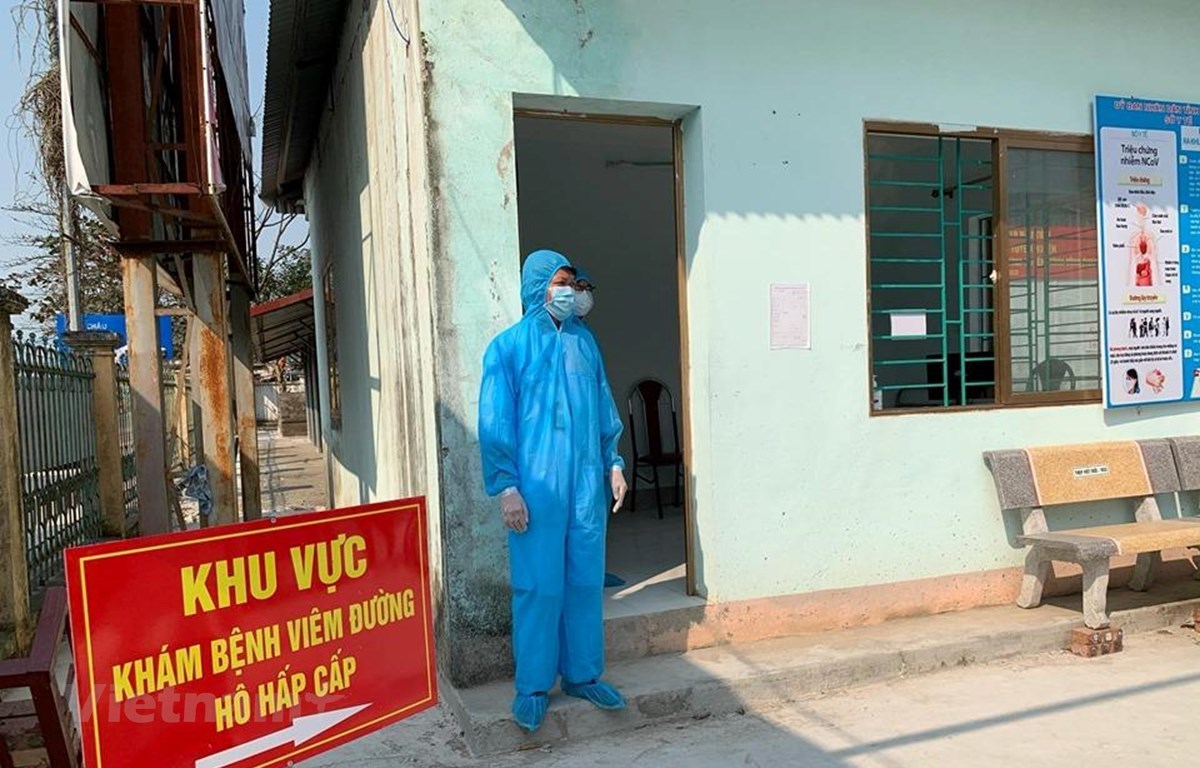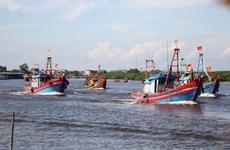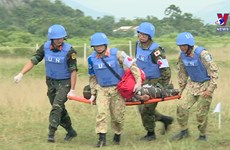Vietnam braces itself to cope with SARS-CoV-2 attack
Facing the urgent COVID-19 situation, Vietnam has carried out an array of measures to contain this disease, which has won over praise from the international community.

A quarantine site at the COVID-19 hotspot in Son Loi commune of Binh Xuyen district, Vinh Phuc province (Photo: VietnamPlus)
Hanoi (VNA) - Over the last about 20 years, many outbreaks of infectious diseases, including new and recurrent ones like Zika (2017), the flu pandemic (2009), A/H5N1 avian flu (2004) and SARS (2003), have shaken the world.
In late 2019 and early 2020, the acute respiratory disease caused by the novel coronavirus SARS-CoV-2, which broke out first in China and then spread to more than 30 countries and territories, have once again stunned the whole world. The number of patients has approximated 80,000 while the death toll has increased day by day, leading to stagnation of numerous activities.
Today’s open world features frequent flows of trade, tourism, labour and cultural exchange, which also poses risks of disease transmission, requiring countries to stay ready to take response actions.
Facing the urgent COVID-19 situation, Vietnam has carried out an array of measures to contain this disease, winning over praise from the international community.
Sudden, rapid attack by SARS-CoV-2
In late January and early February, streets in China’s Wuhan city, the epicentre of the coronavirus outbreak, became empty. Media reported that people only got out of their houses for necessary reasons, and many countries are seeking to evacuate their citizens from Wuhan amid the soaring numbers of SARS-CoV-2 infections and related deaths in this city.
Since the first case was reported in Wuhan of China’s Hubei province in December, the coronavirus has spread rapidly, claiming 26 lives as of January 22.
After more than two months, nearly 80,000 cases have been recorded around the world, including over 2,400 deaths, in more than 30 countries and territories.
According to the World Health Organisation (WHO), SARS-CoV-2 belongs to a large family of coronaviruses found on both humans and animals. They can cause illnesses, ranging from the common cold to more severe diseases like Middle East Respiratory Syndrome (MERS-CoV) and Severe Acute Respiratory Syndrome (SARS-CoV).
Like other respiratory diseases, COVID-19 can cause mild symptoms like a runny nose, sore throat, cough and fever. It may also get severe in some patients and lead to pneumonia, shortness of breath, or even death. Elderly people and those with chronic illnesses like diabetes and heart diseases are likely to suffer from more serious conditions.
The novel coronavirus spreads primarily via droplets when infected people cough or sneeze. It is important that all people practice good respiratory hygiene.
First infections in Vietnam
The acute respiratory disease caused by SARS-CoV-2 has spread rapidly in China, and the WHO has declared the novel coronavirus a global health emergency.
Vietnam, which shares a long borderline with China and has considerable trading and travel volumes with the northern neighbour, is facing a high risk of an outbreak.
The first COVID-19 patients in Vietnam, a tourist from Wuhan and his son, were reported on January 23.
On January 30, testing results of samples at the National Institute of Hygiene and Epidemiology confirmed three other cases of SARS-CoV-2 infection who were Vietnamese citizens returning from Wuhan.
These three patients, together with five other Vietnamese, had been sent to Wuhan for a training course by Japan’s Nihon Plast company and returned to Vietnam on January 17 on flight CZ8315 of Southern China Airlines.
Among the more than 30 countries and territories reporting COVID-19 infections, Vietnam has recorded 16 cases, most of whom are linked with the patients coming to Wuhan for training.
Fighting COVID-19 in all aspects
Shortly after the first persons showing related symptoms were reported, the health sector and the Government have made strong moves to proactively cope with this outbreak.
On January 24, the last day of the old lunar year, when the Lunar New Year atmosphere had come to every corner of the country, the Ministry of Health held a meeting of the steering committee for dangerous and emerging diseases chaired by Deputy Prime Minister Vu Duc Dam to discuss response measures for the time ahead.
This ministry ordered timely quarantine, strict management and monitoring of the first two patients’ treatment at the Ho Chi Minh City-based Cho Ray Hospital so as to prevent virus transmission to medical workers and local residents. It also demanded the health departments of the localities where these patients had come to investigate and list persons with close contact with them.
During the Lunar New Year holiday, health establishments quarantined a number of suspect cases or people having contact with the confirmed cases.
In the spirit of fighting the disease is like fighting an enemy, the Party Central Committee’ Secretariat, the Prime Minister, ministries and sectors have issued many directions shortly after the first infections were recorded in order to prevent the virus from breaking out and spreading in Vietnam.
On February 1, Prime Minister Nguyen Xuan Phuc signed Decision No. 173/QD-TTg, declaring the acute respiratory disease caused by SARS-CoV-2 an epidemic, an unprecedented move in the country.
Following this, relevant agencies have immediately carried out health control measures at ports of entry. The health sector has kept a close watch on health condition of Vietnamese citizens and students as well as tourists from China within 15 days since their arrival. Relevant sectors and localities have also set up local steering boards for coronavirus combat led by chairpersons of provincial-level People’s Committees.
According to Deputy Health Minister Nguyen Thanh Long, the health sector has continuously updated treatment regimens basing on experiences of other countries like China and Thailand.
Aside from investigating persons with cough, fever and shortness of breath, the health sector has also expanded monitoring to others with unclear travel history and tightened control of border crossings and paths, both in the north and the southwest, to prevent illegal exit and entry, while minimising and quarantining those returning from the coronavirus-hit areas.
These are extremely important measures to prevent diseases in other countries from entering Vietnam, Long said, noting that such measures had been implemented to curb the SARS outbreak in 2003 and proved effective.
Vietnam was the first country to successfully bring SARS under control in 2003, and experience in dealing with this pandemic has been optimised thoroughly now, he added.
Meanwhile, the National Institute of Hygiene and Epidemiology recently announced that it had successfully cultivated and isolated SARS-CoV-2 in the laboratory, which is viewed as an important step in developing treatment regimens. Before Vietnam, China, Japan and Australia had also managed to isolate this virus./.
In late 2019 and early 2020, the acute respiratory disease caused by the novel coronavirus SARS-CoV-2, which broke out first in China and then spread to more than 30 countries and territories, have once again stunned the whole world. The number of patients has approximated 80,000 while the death toll has increased day by day, leading to stagnation of numerous activities.
Today’s open world features frequent flows of trade, tourism, labour and cultural exchange, which also poses risks of disease transmission, requiring countries to stay ready to take response actions.
Facing the urgent COVID-19 situation, Vietnam has carried out an array of measures to contain this disease, winning over praise from the international community.
Sudden, rapid attack by SARS-CoV-2
In late January and early February, streets in China’s Wuhan city, the epicentre of the coronavirus outbreak, became empty. Media reported that people only got out of their houses for necessary reasons, and many countries are seeking to evacuate their citizens from Wuhan amid the soaring numbers of SARS-CoV-2 infections and related deaths in this city.
Since the first case was reported in Wuhan of China’s Hubei province in December, the coronavirus has spread rapidly, claiming 26 lives as of January 22.
After more than two months, nearly 80,000 cases have been recorded around the world, including over 2,400 deaths, in more than 30 countries and territories.
According to the World Health Organisation (WHO), SARS-CoV-2 belongs to a large family of coronaviruses found on both humans and animals. They can cause illnesses, ranging from the common cold to more severe diseases like Middle East Respiratory Syndrome (MERS-CoV) and Severe Acute Respiratory Syndrome (SARS-CoV).
Like other respiratory diseases, COVID-19 can cause mild symptoms like a runny nose, sore throat, cough and fever. It may also get severe in some patients and lead to pneumonia, shortness of breath, or even death. Elderly people and those with chronic illnesses like diabetes and heart diseases are likely to suffer from more serious conditions.
The novel coronavirus spreads primarily via droplets when infected people cough or sneeze. It is important that all people practice good respiratory hygiene.
First infections in Vietnam
The acute respiratory disease caused by SARS-CoV-2 has spread rapidly in China, and the WHO has declared the novel coronavirus a global health emergency.
Vietnam, which shares a long borderline with China and has considerable trading and travel volumes with the northern neighbour, is facing a high risk of an outbreak.
The first COVID-19 patients in Vietnam, a tourist from Wuhan and his son, were reported on January 23.
On January 30, testing results of samples at the National Institute of Hygiene and Epidemiology confirmed three other cases of SARS-CoV-2 infection who were Vietnamese citizens returning from Wuhan.
These three patients, together with five other Vietnamese, had been sent to Wuhan for a training course by Japan’s Nihon Plast company and returned to Vietnam on January 17 on flight CZ8315 of Southern China Airlines.
Among the more than 30 countries and territories reporting COVID-19 infections, Vietnam has recorded 16 cases, most of whom are linked with the patients coming to Wuhan for training.
Fighting COVID-19 in all aspects
Shortly after the first persons showing related symptoms were reported, the health sector and the Government have made strong moves to proactively cope with this outbreak.
On January 24, the last day of the old lunar year, when the Lunar New Year atmosphere had come to every corner of the country, the Ministry of Health held a meeting of the steering committee for dangerous and emerging diseases chaired by Deputy Prime Minister Vu Duc Dam to discuss response measures for the time ahead.
This ministry ordered timely quarantine, strict management and monitoring of the first two patients’ treatment at the Ho Chi Minh City-based Cho Ray Hospital so as to prevent virus transmission to medical workers and local residents. It also demanded the health departments of the localities where these patients had come to investigate and list persons with close contact with them.
During the Lunar New Year holiday, health establishments quarantined a number of suspect cases or people having contact with the confirmed cases.
In the spirit of fighting the disease is like fighting an enemy, the Party Central Committee’ Secretariat, the Prime Minister, ministries and sectors have issued many directions shortly after the first infections were recorded in order to prevent the virus from breaking out and spreading in Vietnam.
On February 1, Prime Minister Nguyen Xuan Phuc signed Decision No. 173/QD-TTg, declaring the acute respiratory disease caused by SARS-CoV-2 an epidemic, an unprecedented move in the country.
Following this, relevant agencies have immediately carried out health control measures at ports of entry. The health sector has kept a close watch on health condition of Vietnamese citizens and students as well as tourists from China within 15 days since their arrival. Relevant sectors and localities have also set up local steering boards for coronavirus combat led by chairpersons of provincial-level People’s Committees.
According to Deputy Health Minister Nguyen Thanh Long, the health sector has continuously updated treatment regimens basing on experiences of other countries like China and Thailand.
Aside from investigating persons with cough, fever and shortness of breath, the health sector has also expanded monitoring to others with unclear travel history and tightened control of border crossings and paths, both in the north and the southwest, to prevent illegal exit and entry, while minimising and quarantining those returning from the coronavirus-hit areas.
These are extremely important measures to prevent diseases in other countries from entering Vietnam, Long said, noting that such measures had been implemented to curb the SARS outbreak in 2003 and proved effective.
Vietnam was the first country to successfully bring SARS under control in 2003, and experience in dealing with this pandemic has been optimised thoroughly now, he added.
Meanwhile, the National Institute of Hygiene and Epidemiology recently announced that it had successfully cultivated and isolated SARS-CoV-2 in the laboratory, which is viewed as an important step in developing treatment regimens. Before Vietnam, China, Japan and Australia had also managed to isolate this virus./.
| “Martial law” in all fronts Following the Government’s directions, many ministries and sectors have carried out drastic measures to prevent and control COVID-19. In particular, the Ministry of Education and Training asked leaders of universities, academies, colleges and provincial-level localities to consider school closures through February. The Ministry of Culture, Sports and Tourism suspended or reduced the scale of festivals, limited mass gatherings, and carried out preventive measures in line with the Health Ministry’s guidelines. To ensure strict quarantine of suspect cases, the Prime Minister also requested the Ministry of Public Security and the Ministry of National Defence enhance the management of those subject to quarantine. The Ministry of Labour, Invalids and Social Affairs ordered localities to revoke work permits from foreigners working in Vietnam and subject to quarantine but not complying with quarantine requests or leaving quarantine sites without permission. Meanwhile, the Ministry of Information and Communications has increased reporting on cases not complying with preventive measures, especially those leaving quarantine sites without permission. |













